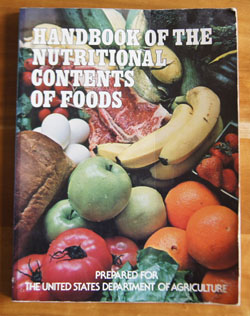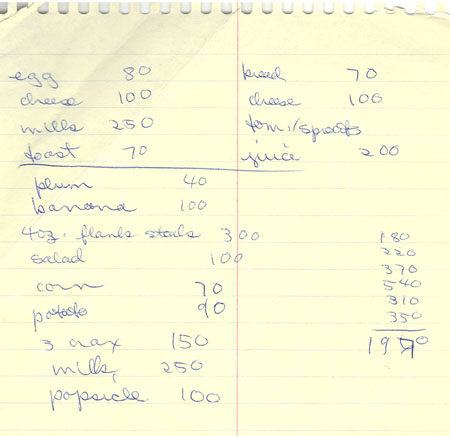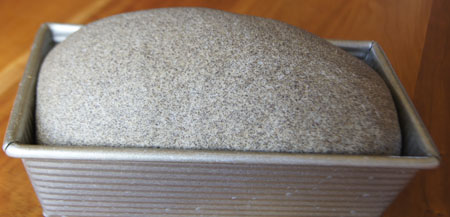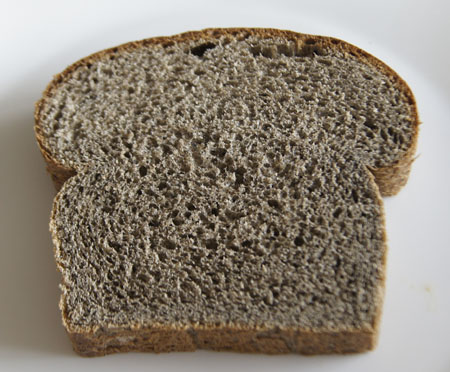Cookbook #216: Handbook of the Nutritional Contents of Foods, prepared by Bernice K. Watt and Annabel L. Merrill for the United States Department of Agriculture, Dover Publications, Inc., NY, 1975.
 I bought the Handbook of the Nutritional Contents of Foods for myself new or used, I think sometime in the eighties. Around that time, I was developing a basic “eating plan” for myself, or maybe I should say “dieting plan”. You see, for years, I would diet strictly for months, eat sensibly for a short time, overindulge for weeks, then repeat the cycle. I drew up my first plan based on a diet given to me in the early seventies, before I left California. Later, The Calculating Cook influenced my diet plan, as well as The Glucose Revolution Pocket Guide to Losing Weight. Those books taught me how to judge food choices as good sources of protein and good or bad carbohydrates. Handbook of the Nutritional Contents of Foods gets down to the dark and dirty of the calories and nutrients in thousands of foods.
I bought the Handbook of the Nutritional Contents of Foods for myself new or used, I think sometime in the eighties. Around that time, I was developing a basic “eating plan” for myself, or maybe I should say “dieting plan”. You see, for years, I would diet strictly for months, eat sensibly for a short time, overindulge for weeks, then repeat the cycle. I drew up my first plan based on a diet given to me in the early seventies, before I left California. Later, The Calculating Cook influenced my diet plan, as well as The Glucose Revolution Pocket Guide to Losing Weight. Those books taught me how to judge food choices as good sources of protein and good or bad carbohydrates. Handbook of the Nutritional Contents of Foods gets down to the dark and dirty of the calories and nutrients in thousands of foods.
I went through a period of counting calories. And I don’t mean simply “counting calories”. I wrote down exactly what I ate each day and calculated the number of calories in each portion of food. At first, I measured portions with measuring cups; later I used a kitchen scale. When I discovered computer databases in the late eighties, I went crazy. I kept computer records of everything I ate, calculated the numbers of calories per day, and correlated it with my weight. I even graphed results. And, I rarely ate out when in a strict dieting phase because it could add an unknown number of calories.
This continued for a long time and the Handbook of the Nutritional Contents of Foods was my ultimate resource for years. This is a very serious, scientific type book that appeals to my scientific nature. More than just calories, I studied my diet to make sure I was getting enough of the nutrients considered essential. I found a page tucked into this book where I listed vitamins and good sources of each.
Here is another sheet of paper I found tucked into this book. It’s a calculation for the total calories I ate one day (and I found a mistake in my calculations):
 One thing I recall about looking up calories in this book is that it was difficult to find the calories in meats. I think maybe it was because I didn’t have a kitchen scale at the time, and would have to estimate the calories from the meat package label, using the amount sold (raw) and estimating the size of the portion I cut for myself.
One thing I recall about looking up calories in this book is that it was difficult to find the calories in meats. I think maybe it was because I didn’t have a kitchen scale at the time, and would have to estimate the calories from the meat package label, using the amount sold (raw) and estimating the size of the portion I cut for myself.
Am I counting calories today? No! Life and food are too much fun, and I want to enjoy both. But, I do know to limit portions and usually do so.
Other books I own and have used to develop a sensible eating plan:
- Jane Brody’s Nutrition Book for nutrition and food additives
- The Nutrition Bible for nutrients and additives
- Complete Book of Food Counts for calories: it is friendly and easy for everyone to use, no vitamins
- Calories and Carbohydrates for calories and carbohydrates
Handbook of the Nutritional Contents of Foods is available on Amazon as a used book: apparently it was never updated. Full text is available on Google books (the cover of the online book is a little different from the cover on my copy.)
The book contents
Handbook of the Nutritional Contents of Foods is a large book (8 3/4 x 12 inches) of 190 pages. It is almost only tables, as described below.
Table 1: Composition of Foods, 100 Grams, Edible Portion. This table gives values for: water content, food energy (calories), protein, fat, carbohydrate, ash, calcium, phosphus, iron, sodium, potassium, Vitamin A, thiamine (vitamin B1), riboflavin (vitamin B2), niacin (vitamin B3), and ascorbic acid (Vitamin C). For many foods, such as meats, values are given for both cooked and uncooked portions. Here’s a photo of a sample page, just to show you how it’s formatted. It’s hard to follow the values for a specific food without a ruler as a guide. Here is a photo of a sample page:

Table 2: Nutrients in the Edible Portion of 1 pound of Food as Purchased. This table gives the same values as Table 1, but for packaged foods rather than standalone foods. This table is not very useful today, because offered backaged foods have changed in the last 41 years, and because we now have nutrient content labels on most packaged foods. This excerpt my own post on Calories and Carbohydrates discusses the introduction of nutrient labels:
“Food products were sold without a nutrition content label. Thus this book once provided a great service. Beginning May 8, 1994, food companies were required by law to begin using nutrient content labels on packaged foods, a label mandated for most food products under the provisions of the 1990 Nutrition Labeling and Education Act (NLEA), per the recommendations of the U.S. Food and Drug Administration.”
Table 3: Selected Fatty Acids in Foods. Useful if you are carefully watching your saturated and unsaturated fatty acid intake. Cooking olis are listed, but the focus is on the food product, be it a fish, meat, dairy product, vegetable, fruit, or bread product.
Table 4: Cholesterol Content of Foods. One page only.
Table 5: Magnesium Content of Food. Ten pages.
The final pages are notes, small tables of miscellaneous values, explanations of where the values for the book were found, and a bibliography.
Will I keep this book? Yes, but mostly for curiousity. The book is over forty years old, after all. And of course, the values are so, so much easier to look up online. I have a few favorite go-to sites for food values, but basically, all you have to do is type the name of a food into a search engine and the food value will pop up.
And what shall I cook for this blog?
There are no recipes in this book. But my last post, PastaMatic MX700, sparked my interest in buckwheat. I had always thought “buckwheat” to be related to “wheat”, but instead it is in the rhubarb family. It is a gluten free grain. I look up the entry in Handbook of the Nutritional Contents of Foods:
Buckwheat flour, dark: 333 cal, 11.7 protein, 2.5 g fat, 72.0 carbs1.6 fiber, ash 1.8, 33 mg calcium 347 phpsphorus, 2.8 iron, no sodium, 0 potassium, 0 A, .58 thiamine .15 riboflavin, 4.4 niacin, no vit c
As a comparison, I look up the values for all purpose white flour: 364 cal, 10.5 protein, 1.0 g fat, 76.1 g carbohydrate, .43 g ash, 16 calcium, 87 phosphorus, .8 iron, 2 sodium, 95 potassium, 0 A, .06 thiamine, .05 riboflavin, .9 niacin, 0 vitamin C.
The only noticeable difference is potassium. But a big difference between white flour and buckwheat flour is the glycemic index. Buckwheat’s GI value is 47, whole wheat flour is 51, and white flour is 66. Any value less than 55 is considered “low glycemic index”. (I found these values from a Google search engine search.) Also, buckwheat flour is gluten free. (Note: in general, when you eat the full grain, such as “groats”, the glycemic index is lower than the value for the flour from the same grain.)
I made My Daily Bread, using 1 cup buckwheat flour, and making to 12 ounces with gluten flour and all-purpose unbleached flour. The buckwheat flour gave a lovely blue-purple-tinged to the loaf. It rose nicely:
 And it baked into a beautiful loaf. Here is a slice, showing the blue hue and the great texture:
And it baked into a beautiful loaf. Here is a slice, showing the blue hue and the great texture:
 I sniffed the loaf like I always do. Pee-yoo, it stinks! Something about the smell really turns me away. I ate a big bite and it tasted like it smelled. Yuck.
I sniffed the loaf like I always do. Pee-yoo, it stinks! Something about the smell really turns me away. I ate a big bite and it tasted like it smelled. Yuck.
I was able to eat a slice with a lot of Whole Foods peanut butter and my own homemade Colorado apricot jam. It was very filling and left me with no lingering stinky after effects. But buckwheat is not for me.
